
Sustainable Farming Index | Virtual Library | Magazine Rack
Search
| Ecological Solutions Roundtable
Towards a more energy efficient cash crop farm
The link between energy and farming is very intimate. Over the years, farming systems that are energy-dependent have been developed. Fossil energy is necessary not only to run tractors and other machineries on-farm but, along with hydro and nuclear energy, in the production and transportation of all inputs that cross the farm gate.
As such, energy-dependency affects the productivity and the profitability of farming. It also has a direct effect on the environment because it involves the emission of greenhouse gasses, and because there are ecological and health risks associated with the transportation of fossil fuel and with the construction and use of hydro-electric or nuclear plants.
The challenge facing agriculture today is to develop farming systems that are productive, economically viable and environmentally sound. The development of such systems will have a major impact on the energy-efficiency of agriculture in general, and of individual farms in particular.
Energy crisis and opportunity
The typical cash crop farm in Quebec produces grain corn, cereals, and soybean. Grain corn is the most important crop as it takes up to 65% of the acreage.
Cash crop farms are particularly involved in today's "energy crisis". While they must reduce their energy consumption for economical and environmental reasons, they are also in a very good position to produce a non-fossil energy for society. Through photosynthesis, farmers transform solar energy into crop biomass, and since it is possible to convert this biomass into some sort of combustible, these farm systems could become net producers of energy.
This scenario is sound only if the amount of energy contained in the farm biomass-energy exceeds the amount of energy that was used to produce, transform and transport the product. The ratio output:input of energy on these farms will have to be very high. However, according to David Pimmentel of Cornell University, this is not the case. He suggests a ratio output:input of energy of about 3:1 at the farm level for corn. Once the energy used to convert the corn into ethanol is accounted for, the ratio output:input of energy falls below one.
Situation of Quebec cash crop farms
Using Table 2 (Energy budget for a cash crop farm), six typical cash crop farms in southern Quebec were recently surveyed. The results are shown in Figure 1, 2 and 3.
Table 2 takes into account all the inputs that the farmers use for production. It does not, however, give an energy value to the soil. If the soil was taken into account, the efficiency of each farm would be lower or higher depending on the state of the soil and the effects of the current soil management practices. Also, the metabolizable energy was used to determine the amount of energy contained in the crop produced. Figure 1 and 2 show two results.

First, there is more solar energy in the crop biomass than the fossil or electric energy used to produce the crops. This result is recorded at the farm gate.
Second, the ratio output:input of energy varies from farm to farm. These ratios are shown in Table 1 for each farm taken as a whole system.
Figure 2


These ratios, though interesting in themselves, are even more revealing in the reasons explaining why such wide differences exist. For instance, how can Farm 1 obtain an energy-efficiency almost twice that of Farm 2?
To answer this question, we have to further explore our analysis. The amount of energy used to produce one tonne of crop is shown in Figure 3 for each farm and each crop.
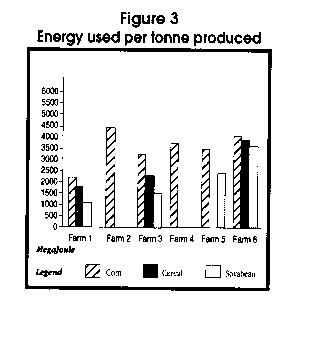
It is clear that different farms require different amounts of energy to produce the same tonnage of crop.
To understand what makes each system so variable in terms of energy consumption we have to realize that the energy input is the energy that is required to produce, transport and use the numerous on-farm inputs such as fertilizers, herbicides, fuel, machinery, etc. The single most important energy input used to produce grain corn is nitrogen (N). On farm systems where grain corn is the most important crop, such as the farms presented here, a similar result can be expected. The proportion of energy contributed by each input used are shown in Figure 4.
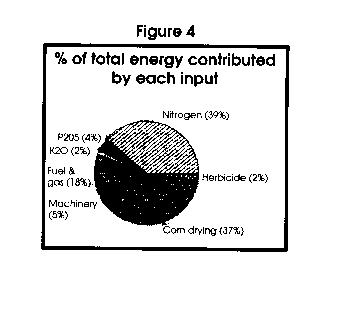
By combining the results of Figure 3 and 4, a better understanding of the situation can be gained.
Farm 1 uses 2,200 megajoules of energy to produce one tonne of grain corn. 38.8% of this energy is in the form of inorganic N. Therefore, for each tonne of grain corn produced 853 MJ is spent in the form of N. For Farm 2, 1,746 MJ of energy is spent in the form of N.
Improving the energy efficiency of a cash crop farm will therefore involve a reduction in use of most inputs, particularly of N and other inorganic fertilizers. Farm 1 indicates a possible direction to succeed in reducing these inputs. Let's look at some of its major characteristics.
Characteristics of an energy-efficient farm system
There are two main differences between Farm 1 and some of the other less energy-efficient farms studied here.
First, Farm 1 grows at least three crops in a rotation where corn follows cereal and a clover green manure and where the cereal follows soybean (corn-soybean-cereal + green manure). The soybean and the clover are legumes that fix nitrogen. Some of this N is kept in the system and is used by the corn and the cereals, reducing the need to purchase inorganic N.
Second, at least half of the corn crop is sun dried using a traditional corn crib. This reduces the need for propane and electricity.
The farm is designed to use renewable and available resources. The rotation and the use of legumes enhances the on-farm recycling of nutrients. Given the importance of inorganic fertilizer, particularly N, as an energy expense, the ability to use and recycle nutrients on-farm will be a key feature of an energy-efficient farm system.
Closing nutrient cycles
To understand nutrient cycling within a farm system it is useful to look at the ecosystem that the current farms have replaced, namely the eastern mixed forest. This natural ecosystem is illustrated in Figure 5.
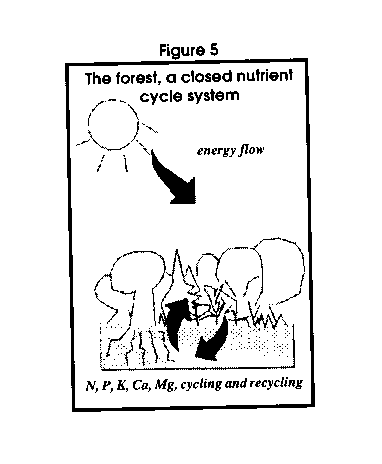
The natural ecosystem works entirely with solar energy. Most of the nutrients taken up by the plants are returned to the soil when the leaves fall or when the plants die. When this organic matter decomposes, the nutrients are slowly released and become available for the growing plants. There is a very intimate link between the organic matter and the nutrients, and between the transformation of the fresh organic matter and the uptake of nutrients by the plants. It is a mechanism whereby the release of nutrients from the decomposition of organic matter is coupled to the uptake by the plants. Nutrients are always returned to the soil attached or incorporated into organic matter. This is a striking difference with a cash crop farm where a third (cereals) to half (corn) of the biomass produced is exported out of the system and where nutrients are returned to the soil in the form of inorganic fertilizers. The farm system is shown in Figure 6.
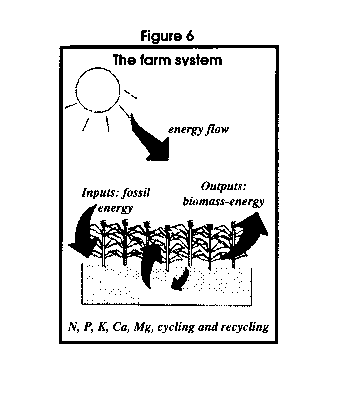
There are two means by which the farm system can mimic the long lasting ecosystem.
First, by using a greater diversity of crops. The roots of these crops will colonize different areas of the soil and will bring back into the system nutrients that would otherwise be lost. Some of these crops would have to be legumes and contribute to the nitrogen self-sufficiency of the system. This is the approach taken by Farm 1 presented above. The second way is by recycling and transforming on-farm organic materials that would otherwise be wasted. Some possibilities include:
• manure coming from animal producing farms with little land available;
• commercial waste coming from supermarkets, food processing plants etc.;
• and municipal waste coming from water treatment plants.
All three sources represent a huge pool of fresh organic matter and nutrients that could be incorporated into the design of cash crop farms.
Both of these possibilities require that the farmer, through observation and trial and error, adjust the management of crop residues, fresh organic matter and soil organic matter in such a way that the release of nutrients from their decomposition is synchronized with their uptake by the plants. When the nutrient release and the plant uptake are coupled, the system can function with very little mineral inputs and more of the nutrients are kept and recycled within the system. The result is a farm system that is less energy-dependent.
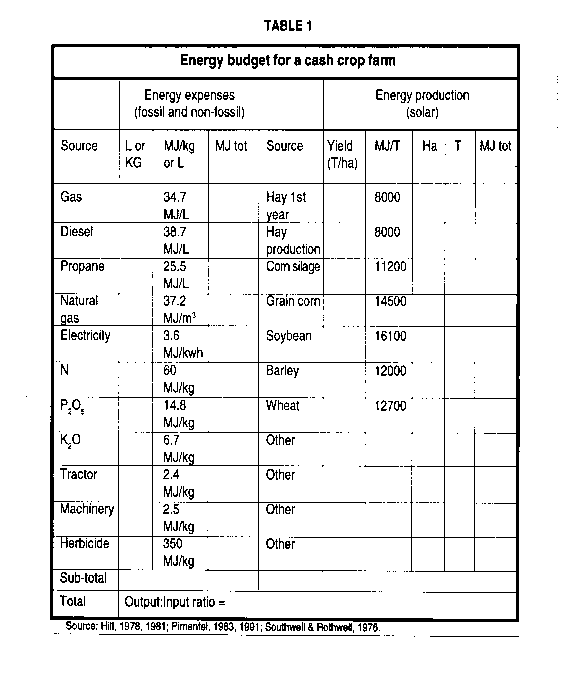
Copyright © 1995 REAP Canada
Reprinted with permission. All rights reserved.
Info Request | Services | Become EAP Member | Site Map
Give us your comments about the EAP site
Ecological Agriculture Projects, McGill University (Macdonald
Campus),
Ste-Anne-de-Bellevue, QC, H9X 3V9 Canada
Telephone:
(514)-398-7771
Fax:
(514)-398-7621
Email: info@eap.mcgill.ca
To report problems or otherwise comment on the structure of this site, send mail to the Webmaster